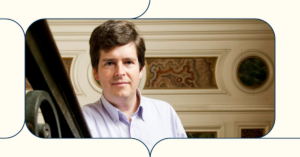The Jean Mandel Prize
Since 1982, the Jean Mandel Prize has rewarded promising young researchers and teams in the field of mechanics of materials, soils and structures.
Discover the history, the winners and the impact of this prize, a pillar of scientific and technological innovation.

The Prize
The Jean Mandel Prize, organized by Mines Paris – PSL and École Polytechnique, is a biennial award for innovative research in the mechanics of solids and materials. Created in memory of Jean Mandel, an emblematic figure in these disciplines, the prize embodies his legacy by encouraging younger generations of researchers. Endowed with 8,000 euros, it highlights contributions.
Jean Mandel (1907-1982) left his mark on the history of the mechanical sciences through his pioneering work in plasticity, rheology and the modeling of heterogeneous materials. Professor at Mines Paris – PSL and École Polytechnique, he founded the Laboratoire de Mécanique des Solides and contributed to fundamental advances with industrial applications.
How to enter
The competition is open to young researchers or teams of researchers under 40, French or working in France, or for French researchers abroad, who have joined a laboratory in France. Candidates will be required to present a dossier at Habilitation à Diriger des Recherches level, or to demonstrate an innovative application of known work. Applications, comprising a CV, scientific documents and independent assessments, must be sent electronically by the deadline.
Contact and information
If you have any questions, please contact the jury secretary, Samuel Forest, at the Centre des Matériaux de Mines Paris – PSL :
- Email: samuel.forest@minesparis.psl.eu
- Postal address: BP 87 – 91003 Évry – France
Jean Mandel Award winners
Since its creation, the prize has rewarded many researchers who have made their mark in their field:
1982 – Bernard Halphen
Pioneering contributions to modeling the plasticity of materials, paving the way for advances in structural mechanics.
1983 – François Mudry
Development of a local approach to fracture, taking into account the statistics of defects in industrial materials and components, notably nuclear.
1984 – Jean-François Agassant
Work on polymer rheology, with applications to industrial forming processes.
1985 – Olivier Coussy
Recognized for his research into the mechanics of porous media, essential for geomechanics and cement structures.
1986 – Marc Abouaf
Innovations in numerical simulations applied to powder metallurgy and materials behavior.
1987 – Patrick de Buhan
Theoretical contributions to soil mechanics, particularly in assessing the stability of geotechnical structures.
1988 – Pierre Suquet
Major advances in the homogenization of heterogeneous materials and multi-scale behavior laws.
1989 – Jean-Baptiste Leblond
Innovative research into plasticity and fracture models for metals and alloys.
1990 – Philippe Bensussan
Theoretical and experimental approaches to high-temperature fracture mechanics.
1991 – Luc Dormieux
Development of models for the mechanics of porous media, with applications in petroleum engineering.
1992 – Gilles Pijaudier-Cabot
Work on quasi-fragile materials and fracture mechanics in cementitious structures.
1993 – Olivier Allix
Specialist in multi-physical couplings and damage in composite structures.
1994 – Bruno Cochelin
Research into instabilities in non-linear structures and dynamic systems.
1995 – Patrick Ballard
Innovations in rigid solid dynamics and numerical shock simulation.
1996 – Jacques Besson
Contributions to the modeling of damage and ductile fracture in metal structures.
1997 – Michel Bornert
Development of experimental and numerical approaches for multi-scale analysis of materials.
1998 – François Hild
Advances in experimental mechanics, notably in image correlation for deformation monitoring.
1999 – Han Zhao
Innovative research on fast dynamics and impact testing in mechanics of materials.
2000 – Siegfried Fouvry
Study of tribological phenomena and interfaces in complex mechanical systems.
2001 – Samuel Forest
Contributions to multi-scale models and behavior laws for crystalline heterogeneous materials.
2003 – Marc Fivel, Nicolas Moës
Modeling of metal microstructures using dislocation dynamics (Fivel), and XFEM method for numerical damage and fracture mechanics (Mpës).
2005 – Bruno Sudret
Development of probabilistic tools for uncertainty analysis and reliability in engineering.
2007 – Nicolas Roussel
Mechanics of cementitious materials and rheology applied to concrete.
2009 – Amine Ammar
Numerical methods for complex fluids and solids in multi-physics systems.
2011 – Julien Réthoré
Development of numerical and experimental approaches to the mechanics of brittle structures.
2013 – Yann Gueguen
Experimental contributions to glass mechanics.
2015 – Nicolas Auffray, Romain Quey
N. Auffray for his work in anisotropic modeling of architectural materials and R. Quey in calculating polycrystalline structures.
2017 – Sébastien Brisard, Thilo Morgeneyer
Innovative modeling and simulation in mechanics of heterogeneous materials (Brisard) and three-dimensional damage characterization of metals and metal alloys (Morgeneyer).
2019 – Cédric Bellis, Konstantinos Danas
C. Bellis for his work on imaging solid media, inverse problems, waves in complex media, homogenization and associated asymptotic models, K. Danas on homogenization of nonlinear solids and magneto-mechanical behavior of elastomeric composites.
2021 – Laurence Bodelot, Kim Pham
L. Bodelot for her original work on couplings in magneto-rheological elastomers and problems at the interface between the mechanics of materials and the physicochemistry of thin films, K. Pham on wave propagation in complex media and in particular in metasurfaces and metamaterials.
2023 – Jérémy Bleyer, Vladislav Yastrebov
J. Bleyer, for his work in modeling and numerical simulation of fracture in civil engineering structures and materials, in particular, and V. Yastrebov in modeling and simulation of contact and friction phenomena in material structures and microstructures.
2025 – Claire Lestringant, Léo Morin
C. Lestringant for her theoretical and numerical work on dimension reduction, asymptotic homogenization, and cracking of granular materials, and L. Morin for his research in nonlinear mechanics of heterogeneous materials, combining theoretical, numerical, and experimental developments.
To find out more
“Promoting excellence in solid mechanics and materials research”: three questions to Samuel Forest on the launch of the Jean Mandel 2025 Prize competition.


